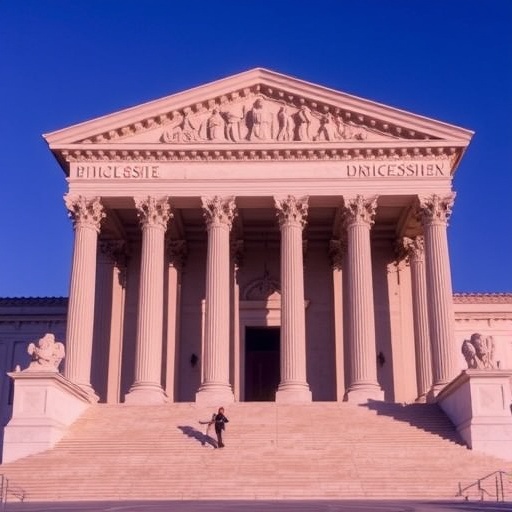In a move that could fundamentally alter the electoral landscape of the United States, the Supreme Court is set to hear oral arguments this week in a landmark case challenging redistricting practices under the Voting Rights Act. At the center of the dispute is Alabama’s congressional map, accused of diluting Black voters’ influence in violation of federal protections—a battle that pits state autonomy against safeguards for minority representation and has civil rights advocates on high alert.
Alabama’s Map Draws Fire: The Core Allegations in the Redistricting Clash
The case, known as Merrill v. Milligan, stems from a federal trial court’s ruling that Alabama’s 2021 redistricting plan unlawfully weakened Black voting power. With Black Alabamians comprising 27% of the state’s voting-age population, the plaintiffs argued that only one of the seven congressional districts offered a realistic chance for Black-preferred candidates to win. This, they claimed, contravenes Section 2 of the Voting Rights Act of 1965, which prohibits practices that dilute minority votes based on race.
Alabama’s Republican-led legislature defended the map as race-neutral, emphasizing traditional districting criteria like compactness and community interests. However, lower courts found evidence of racial gerrymandering, pointing to data showing that the current configuration packs Black voters into a single district while spreading others thinly across safe Republican seats. Statistics from the Brennan Center for Justice underscore the stakes: nationwide, gerrymandered maps have led to a 10-15% underrepresentation of minority voices in Congress since the 2010 redistricting cycle.
Civil rights groups, including the NAACP Legal Defense Fund, have flooded the Supreme Court with amicus briefs, warning that upholding Alabama’s map could embolden similar tactics in states like Georgia, Louisiana, and South Carolina. ‘This isn’t just about Alabama; it’s a blueprint for suppressing votes across the USA,’ said DeBo Adegbile, a prominent voting rights attorney. The case arrives amid a surge in litigation, with over 200 redistricting challenges filed post-2020 Census, highlighting how redistricting has become a flashpoint in American democracy.
Historical context adds weight: The Voting Rights Act, born from the bloody struggles of the Civil Rights Movement, has been the bulwark against disenfranchisement. Yet, the Supreme Court‘s 2013 decision in Shelby County v. Holder gutted key preclearance provisions, leading to a 30% increase in restrictive voting laws, according to the ACLU. This case tests whether Section 2 can fill that void or if the Court will further erode federal oversight on state redistricting.
Justices’ Past Rulings Cast Long Shadows Over the Proceedings
As the Supreme Court convenes, the ideological fault lines are stark. Chief Justice John Roberts, who authored the Shelby opinion, has historically favored state discretion in elections, viewing federal intervention as overreach. In contrast, Justices Sonia Sotomayor and Ketanji Brown Jackson—both with deep ties to civil rights litigation—have signaled strong support for robust enforcement of the Voting Rights Act. Jackson, in her confirmation hearings, emphasized that ‘voting rights are not a partisan issue; they are the foundation of our republic.’
Recent precedents loom large. The Court’s 2022 decision in Allen v. Milligan—a companion case—affirmed that Section 2 applies to redistricting but stopped short of mandating new maps, leaving room for states to comply minimally. Critics argue this created a loophole, allowing maps that technically pass muster while still disadvantaging minorities. Data from the Princeton Gerrymandering Project reveals that in 2022 midterms, gerrymandering cost Democrats up to 10 House seats, disproportionately affecting districts with high minority populations.
Conservative justices like Clarence Thomas and Samuel Alito have questioned the ongoing relevance of race-based remedies, with Thomas once calling the Voting Rights Act a ‘perpetual license’ for racial classifications. Yet, even some GOP-led states have filed briefs urging the Court to uphold Section 2, fearing a backlash that could upend their own maps. ‘Redistricting is a zero-sum game,’ noted election law expert Rick Hasen in a recent op-ed. ‘A win for Alabama could mean chaos in battleground states ahead of 2024.’
The oral arguments, scheduled for October 4, 2023, will likely probe these tensions. Expect pointed questions on how courts should measure ‘dilution’—whether through statistical models like the efficiency gap or traditional vote dilution tests. With the Court’s 6-3 conservative majority, outcomes could range from a narrow affirmance of the lower court to a sweeping reinterpretation that limits future challenges.
Stakeholders Rally: Quotes and Concerns from Across the Political Spectrum
The national spotlight on this Supreme Court case has mobilized a chorus of voices, from grassroots activists to political heavyweights. In Alabama, where the case originated, Black voters like Marshe Turner, a plaintiff in the suit, have shared harrowing stories of marginalization. ‘We’ve come too far to let maps drawn in backrooms silence us,’ Turner told reporters outside the federal courthouse in Montgomery. Her words echo the sentiments of over 50,000 petition signers supporting a redraw.
On the defensive, Alabama Attorney General Steve Marshall defended the state’s approach in a press conference, stating, ‘Our map respects the will of Alabama voters and adheres to constitutional principles. Injecting race into redistricting only divides us further.’ Marshall’s office cited a 2022 state audit showing the map’s compliance with population equality standards, with deviations under 1%—well within legal bounds.
Beyond Alabama, the case resonates in the USA’s redistricting battlegrounds. In Louisiana, where Black voters make up 32% of the population but hold just one of six congressional seats, advocates fear a Supreme Court green light for similar dilution. ‘This could lock in minority underrepresentation for a decade,’ warned Vanita Gupta, head of the Justice Department’s Civil Rights Division under Biden. Gupta’s team has intervened in support of the plaintiffs, filing a brief that highlights how post-Shelby laws have suppressed turnout by 2-5% in affected communities, per MIT election data.
Republican strategists, speaking off the record, express mixed views. One GOP consultant from the South told Politico that while a victory would solidify safe seats, it risks alienating moderate voters in swing districts. Meanwhile, progressive groups like FairVote are pushing for independent redistricting commissions, pointing to states like Michigan and Colorado where such reforms reduced gerrymandering by 40%, according to Ballotpedia.
The economic angle can’t be ignored: Gerrymandered districts distort policy priorities, leading to underinvestment in minority-heavy areas. A 2023 Urban Institute study found that racially gerrymandered states allocate 15% less per capita to education and health in Black communities, perpetuating cycles of inequality.
National Implications: How a Ruling Could Reshape Elections and Democracy
If the Supreme Court sides with the plaintiffs, Alabama—and potentially a dozen other states—could be ordered to redraw maps, creating more competitive districts and boosting minority representation. This might flip 5-10 House seats in 2024, per simulations from the Cook Political Report, tilting the balance toward Democrats in a narrowly divided Congress. Conversely, a ruling favoring Alabama would validate race-blind redistricting, potentially invalidating ongoing challenges in New York, Ohio, and North Carolina, where courts have struck down GOP maps.
The broader ripple effects on voting rights are profound. With the 2030 Census looming, states would have freer rein to craft maps favoring incumbents, exacerbating polarization. The Brennan Center estimates that extreme gerrymandering has already contributed to a 20% drop in competitive races since 2000, stifling voter choice. In the USA, where turnout hovers at 66%—far below nations like Sweden’s 87%—such distortions undermine faith in elections, as evidenced by a 2023 Pew Research poll showing 40% of Americans doubt the fairness of redistricting.
Looking ahead, the decision could spur congressional action. Bipartisan bills like the Freedom to Vote Act, which includes redistricting reforms, have stalled but might gain traction if the Court signals weakness in federal protections. Civil rights leaders are already organizing nationwide campaigns, with events planned in 20 cities to pressure the justices. As one expert put it, ‘This case isn’t just about lines on a map; it’s about who gets to draw the future of American democracy.’
Regardless of the outcome, the hearings mark a critical juncture. With oral arguments this week, the nation watches as the Supreme Court grapples with its role in safeguarding voting rights amid an era of heightened partisan strife. The ruling, expected by summer 2024, will not only influence immediate electoral maps but also set precedents that echo through decades of political battles.








